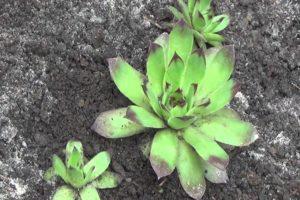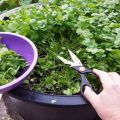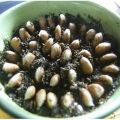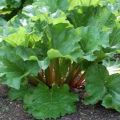Growing and caring for calla lilies at home, combating diseases
Calla is a plant of the aroid family native to Africa. In its natural environment, it reaches a height of more than two meters. Culture attracts Russian gardeners with an unusual look with large flowers that resemble a funnel and a heart at the same time. It is not necessary to plant the plant in open ground, the care and cultivation of callas is practiced at home.
Is it possible to keep calla lilies at home
If you organize the temperature and humidity of the air close to natural, the culture develops normally and blooms in a pot on the windowsill. The question is different, flower growers are interested in energy compatibility with calla lilies.
The South African flower is shrouded in mystery and mysticism. According to some beliefs, it is believed that the plant is a divine amulet, a talisman for good luck, since it bloomed next to the cross on which Jesus was crucified, it is present in the images of angels, the Virgin Mary.
Others are sure that calla blooms on the eve of death, it is appropriate for a funeral rite, as it looks like a yellow candle wrapped in a white shroud.
Most gardeners are of the opinion that calla brings prosperity to the family, reconciles quarreling spouses. A pot with calla lilies in the office maintains a friendly atmosphere in the team, helps in negotiations with business partners.
It has been noticed that calla, flowering at home, relieves the condition of patients with heart failure.

Which varieties are suitable for home cultivation
The height, color of flowers, and the type of root system depend on the species of callas. The ancestor of domesticated crops, the Ethiopian calla is distinguished by its 1.5-meter height, snow-white color, and the presence of rhizomes.
Elliot's varieties are yellow and golden, up to half a meter high. Calla lilies of the Remann type are pink with low peduncles. In the latter two species, the underground part is represented by tubers.
Common varieties adapted for home cultivation:
- Schwarzwalder. Flowers almost black with a burgundy tint look very impressive. The average plant height is 60 cm. Flowering begins in mid-July and ends by September. The culture is decorated with bright green, erect leaves with white spots.
- Vermeer.The color of flowers is white outside, inside - closer to purple. The ear is bright, canary-colored. The decorativeness of the plant is given by white blotches in the rich green of the leaves.
- Mango. The variety is suitable for growing on a windowsill and outdoors. A yellow ear, golden-orange cover of peduncles looks good when cut. Leaves are green with silvery specks.
- Amethyst. The color of the flowers corresponds to the name. The potted culture gives off a pleasant, delicate aroma. The leaves grow above the peduncles.
- Red Alert. The variety stands out for its large red flowers, large speckled leaves. Red Alert differs from other varieties by long flowering - all summer period.
- Hot Shot. Popular tuberous plant. Translated from English - hot shot. Depending on the time of flowering, conditions of detention, it changes shades from peach to orange-red. Above, the leaves are of a standard color, brown veins are visible from the inside.
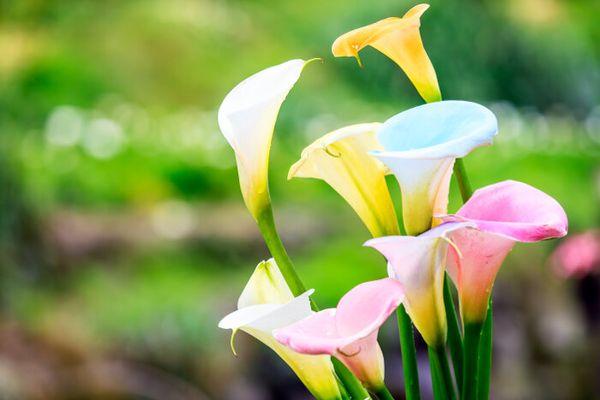
The presented varieties are similar in appearance. The average height of the plants is 60 cm, the size of the flowers is 10 cm. The inflorescence consists of an ear and a blanket that forms a funnel. The basal leaves are shaped like an arrowhead, the color is green with silver-white splashes.
Requirements for growing conditions
Growing calla lilies on the windowsill is possible even for novice amateur flower growers who follow the care recommendations. It is required to create conditions close to natural.
Illumination
Kalle needs continuous lighting throughout the year, including a dormant period.
Lack of light leads to yellowing of foliage, lack of flowering or faded color.
Direct sunlight causes leaf burns, so the plant pots located on the windowsill are fenced off with translucent tulle.
Temperature regime
Ethiopian white calla lilies thrive in temperatures between 18-20 ºC. Plants overwinter in heated rooms with temperatures of at least 14-18 ºC.
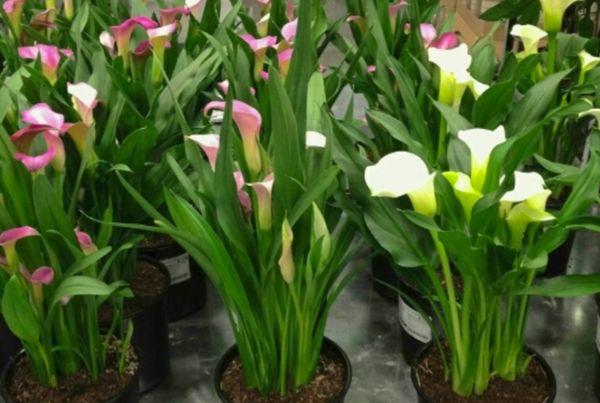
For colored tuberous calla lilies, the optimum temperature range is 22–25 ºC. The dormant period of the bulbs is safely tolerated at + 3-7 ºC. Sharp temperature jumps lead to the cessation of flowering. On the loggias, open terraces calla lilies are carried out only in summer.
Humidity
Moisture is an important factor in growing a plant. In the subtropical swamps of South Africa, where calla lilies come from, the humidity is high - 70-80%. If the indicators in the apartment do not correspond to the norm, the culture is sprayed twice a day - in the morning and in the evening, the leaves are regularly wiped with a damp cloth.
Required soil composition and pot size
Despite the lightness of the products, a wide range of different volumes and configurations, the plastic pot is inferior in quality to the clay one. Pottery is porous, which allows excess moisture to evaporate. They have a universal color suitable for different types of calla lilies.
For the Elliot and Remani species, pots with a diameter of up to 20 cm are needed. For children, even less - 10 cm. Ethiopian calla lilies with a developed rhizome require a container with a diameter of 30–40 cm, a height of 60. A suitable soil for calla lilies consists of equal parts of peat, garden soil, sand and two parts of organic matter - humus or rotted manure. The soil should be slightly acidic, the optimum pH is six.
Planting room calla lilies technology
How the plant will develop and bloom in the future depends on the correct embedding of the planting material. It is necessary to take into account the timing, maintain the landing technology.
Terms of planting works
It is recommended to plant tubers after the end of the dormant period. In tuberous varieties, a new life cycle begins from late February to mid-March, and in rhizomatous varieties from mid-July.
We plant the bulbs
How to plant bulbs in pots, algorithm:
- overwintered tubers are examined for dry rot;
- remove damaged areas by smearing sections with brilliant green;
- to protect against pests and diseases, the bulbs are treated with fungicides;
- a drain is placed on the bottom of the container, filled with a substrate by two-thirds;
- the soil is compacted, the planting material is laid out;
- sprinkle with earth on top with a 2-centimeter layer;
When the seedlings reach 5–7 cm, they fill up the soil to prevent the root from coming out to the surface.

We sow with seeds
Subject to planting technology, calla is grown from seeds obtained from the left peduncle, purchased in the store.
Start by soaking. Use clean water or add a growth promoter. After 6 hours, the seeds are transferred to a shallow container, the bottom of which is lined with wet cotton pads. Cover with a wet gauze napkin and put in a warm place with a temperature of at least 20 ºC for 5–7 days. The gauze should not dry out.
Small holes, 3 cm deep, are made with a stick or pencil, watered. To ensure the emergence of sprouts, several seeds are planted. To facilitate germination, planting material can not be buried, but scattered from above. In this case, the seeds are pressed, glass or film is placed on the pot. It is recommended to leave no more than two shoots in a pot.
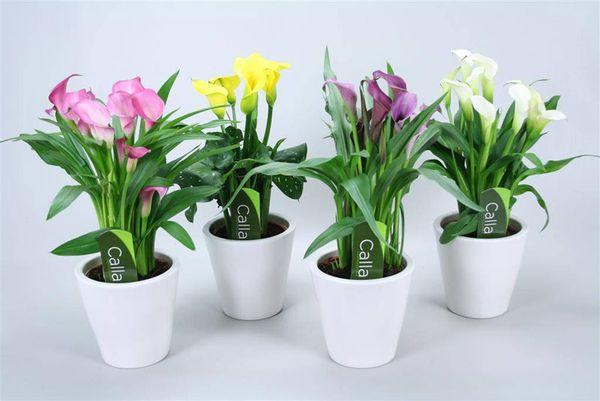
Home calla lilies: care
Caring for calla lilies at home includes a list of standard agrotechnical measures: watering, feeding, pruning. Annual transplants and the organization of a rest period are required.
Features of watering and spraying
Abundant watering of the culture is needed during the period of active growing season, flowering. The root germination occurs during the first 2-3 weeks after planting. Calla lilies are not watered at this time.
Further, the culture is irrigated with warm, settled water daily in a moderate amount. When the flower formation is over, watering is performed as the top layer of the soil dries up. Ethiopian calla, which grows in swamps in the natural environment, is especially demanding on moisture.
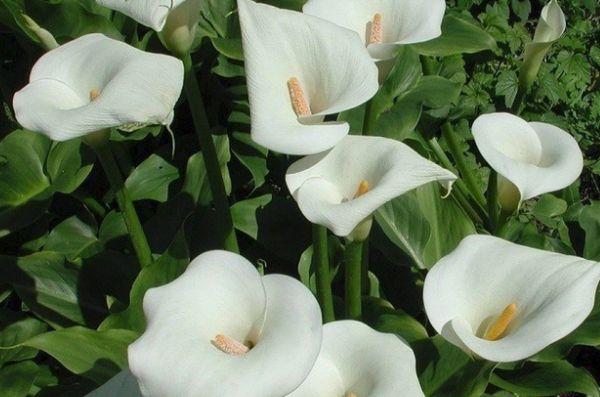
It is recommended to irrigate the crop with a narrow-nosed watering can, guiding it into a shallow groove along the edges of the pot. The ingress of moisture on the tuber causes the development of putrefactive processes, the appearance of diseases. After watering, it is unacceptable to leave water in the pan.
At high temperatures and low humidity, spraying from a spray bottle is required. Drops falling on the flowers spoil the appearance of the bedspread, so during the flowering period it is better to wipe the leaves with a damp cloth.
What top dressing do we prefer the plant
For normal growth and flowering, calla lilies need to be fed monthly. Vegetation of leaves and the laying of peduncles are promoted by potassium nitrate, superphosphate. To prolong the flowering of the culture, purchased preparations with a complex of minerals and trace elements are introduced into the soil.

Once a year, to enrich the substrate with nutrients and stimulate flowering, the soil is fertilized with organic matter. Starting from the moment of planting, mineral complexes are introduced weekly in small doses for a month. Next, the plant is fed once a month.
It is possible to combine the introduction of trace elements and minerals, and organic matter is introduced separately, maintaining the interval between agricultural activities for at least a month.
Pruning
Formative pruning for calla lilies is not practiced. Only the lower dried leaves and aerial wilted parts of the plant are removed before being sent to rest.
When and how to transplant a flower correctly
Calla lilies are transplanted every year in the spring after coming out of dormancy and in unforeseen situations. For example, when a pot fell from the windowsill or the plant got sick. In these cases, it doesn't matter if the culture grows, blooms or rests.

The transplant technology is simple:
- prepare a more spacious pot with a drainage of 5 cm and a new loose substrate;
- remove the calla from the old container;
- shake off the soil adhering to the root;
- tubers are treated with fungicides or potassium permanganate;
- the plant is placed in a recess made in new soil;
- without pressing down the root, calla lilies are carefully covered with earth;
- lightly tamp the surface.
Calla lily juice is poisonous, so it is recommended to transplant with gloves so as not to cause burns and allergic reactions of the skin of the hands. If children have formed on the tuber, they are seated in small pots 10 cm in diameter. The calla root is deepened by 5–10 cm.
How to care for a crop during a dormant period
Calla lilies need rest to recuperate and form new peduncles. The dormant period begins at the end of flowering. By gradually reducing, they negate soil moisture.
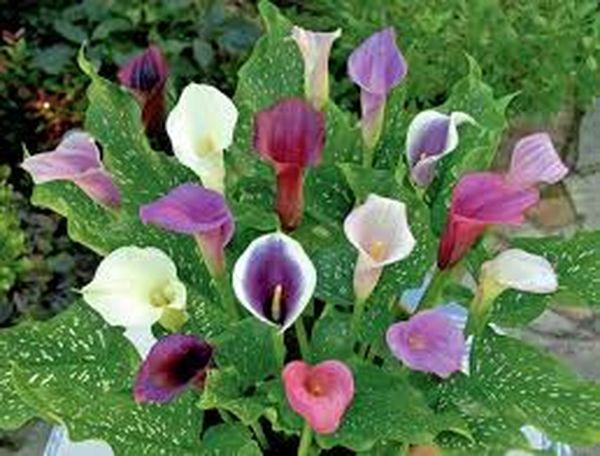
After the leaves and peduncles die off, the tuber is dug out, washed, soaked in potassium permanganate. After drying, it is placed in a container with dry sand, which is transferred to a cool place. Or stored in paper bags in the vegetable section of the refrigerator. Additional care for calla lilies during the rest period is not required.
There are significant differences in the dormancy of crops with different types of root systems. In rhizome calla lilies, the life cycle ends by the end of spring, and in tuberous callas - in autumn. Ethiopian calla lilies are sent to rest until mid-July, then transplanted into a new substrate.
Potential problems and difficulties in growing
When growing calla lilies, growers are faced with the absence of peduncles, yellowing of the leaves, the appearance of diseases and attacks of insect pests. Only armed with knowledge, you can overcome difficulties, eliminate mistakes in the future when caring for a plant.
Diseases and pests of flowers: control methods
More often calla lilies are affected by fungal, less often bacterial diseases. Aphids and spider mites are widespread pests of the culture. They fight insects by spraying with soap solutions, Iskra, Komandor, Fitoverm, Lightning preparations.
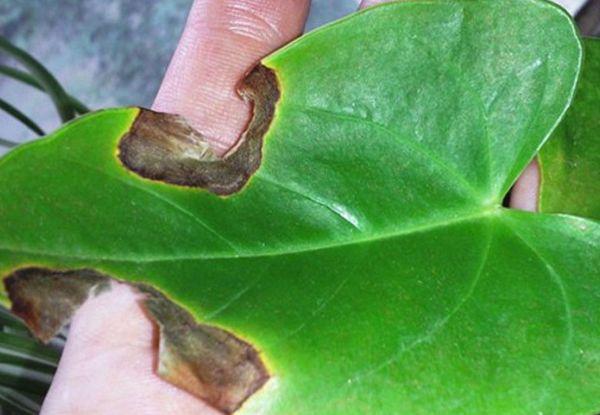
Anthracnose
Waterlogging of the soil, high temperature and humidity of the air lead to the appearance of small brown spots on the leaves of the calla. Over time, the diameter of the spots increases, the center turns white, and the edges are bordered by a red stripe. Leaves and flowers fade, weaken, dry up and curl.
Measures to combat fungal disease include removing damaged parts of calla lilies, reducing the intensity of irrigation, treating the plant with Fitosporin-M, Fundazol.
Gray rot
The disease caused by the fungus Botrits cinera affects the leaves, stems, flowers of the culture. A gray bloom immediately forms on the leaves. On the flowers, patches of gray-green appear, which turn brown over time. In the future, the bedspread acquires a dirty gray coating. Like all fungal diseases, gray rot develops in conditions of excessive heat and humidity.
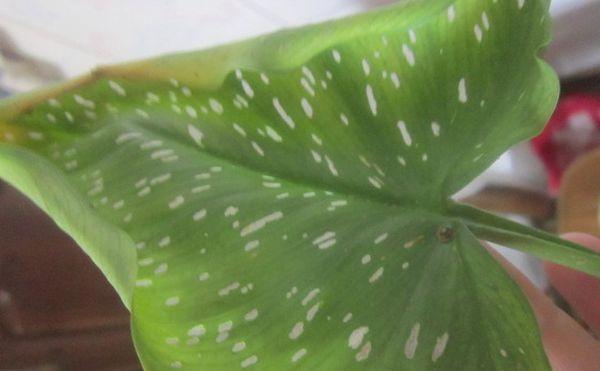
When spots appear, the diseased parts of the plant are removed, the intensity of moisture is reduced. From fungicides, the preparations Gamair, Trichodermin, Rovral are suitable for the fight.
Bacterial rot
The characteristic signs of a bacterial disease are rotting of peduncles, leaves at the base. The aboveground parts of the plant gradually die. The roots get wet, acquire brown spots.
The disease does not respond to treatment. The infected culture is disposed of. Preventive measures include careful selection of planting material, treatment of tubers and rhizomes with fungicides before planting, exclusion of mechanical damage to an adult plant.
Root rot
External symptoms are darkening, active wilting of leaves, peduncles, plant death. The roots are covered with dry rot.

The disease is treated by treating calla lilies with fungicides:
- Mikosan, which produces antibodies to fungal diseases;
- Discor, safe for humans;
- biological preparation Trichophyte;
- effective Trichodermin.
When the leaves darken, watering is stopped, the upper part of the soil is replaced with a new one.
Lack of flowering
Adult calla does not bloom in the following cases:
- selection of low-quality planting material;
- planting crops not according to the rules - without observing the norms for the depth of embedding of the tuber into the substrate;
- improperly selected pot;
- lack of rest in winter;
- non-compliance with the dosage of nitrogen-containing drugs;
- lack of irrigation;
- sharp temperature changes.
Lack of light and nutrients in the soil plays a negative role in the absence of flowering. Calla feels uncomfortable with frequent transplants, changing the location of the pot, as well as when being in the same container for a long time without changing the soil.

Potassium and phosphorus fertilization, treatment with Zircon, removal of dried-up parts of the plant contribute to budding.
Do the leaves turn yellow and dry?
The yellowing of calla leaves is due to natural causes (aging of the plant) and non-compliance with care recommendations. The leaves of the culture live for six months, then gradually die off. If the wilting process begins at the lower leaf plates or in the fall before a dormant period, there is no reason for concern.
The main factors for yellowing leaves:
- drying out of the soil or stagnant water in the pot;
- air temperature below 18 or above 27 ° C;
- cramped container;
- lack of disease prevention, protection from pests;
- drafts;
- burn from direct sunlight.

If, after the normalization of watering, in the absence of insects and signs of disease, the leaves continue to wither, the plant is removed from the soil, and checked for rot. Remove damaged parts of the root, while the leaves do not need to be torn off. The greens should die off on their own.
Further, the culture is placed in a container with water with a dissolved activated carbon tablet, kept until new processes appear. At the onset of a dormant period, they are removed to a cool place. Plant the culture in a smaller pot with a new substrate.
